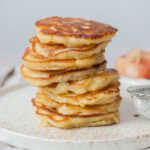Polish Apple Pancakes (with yeast)
Servings: 4 servings
Ingredients
for the pancake batter:
- 20 g fresh yeast or 1 packet/7g active dry yeast or instant yeast
- 1 cup (240g) milk
- 2 cups (250g) flour spooned and leveled, not scooped
- 2 large eggs
- 1/4 cup (50g) sugar divided
- 2 teaspoons vanilla extract or 1 Tbsp vanilla sugar
- 1/4 teaspoon cinnamon
- 1/4 teaspoon fine sea salt
- 5 small/medium apples soft variety
additionally:
- frying oil
- powdered sugar for dusting
Instructions
- Heat the milk until pleasantly warm to the touch (it's best to check its temperature with a thermometer, it should be 100-110°F (38-43°C)). The milk can't be too cold or too hot or the yeast won't work.1 cup (240g) milk
- STEP 2: Add milk to a medium bowl and add yeast, 1 Tbsp of sugar, and stir together. Set aside for 10 minutes for the yeast to bloom (they will become foamy). If there is no foam, you need to start over. Although it is not necessary for the instant yeast to be proofed (you can add it directly to the flour) I've found that this way the dough rises quicker and you can be sure that your yeast is working.20 g fresh yeast or 1 packet/7g active dry yeast or instant yeast
- Add the milk-yeast mixture and all the other ingredients except apples to a large bowl (flour, eggs, vanilla, 3 Tbsp of sugar, cinnamon, salt). Mix with an electric mixer for about 1 minute, until well combined (don't worry about overmixing the mixture, it will have time to rest).2 cups (250g) flour, 2 large eggs, 2 teaspoons vanilla extract, 1/4 teaspoon cinnamon, 1/4 teaspoon fine sea salt, 1/4 cup (50g) sugar
- Cover the bowl with a piece of plastic foil or kitchen towel and set aside in a warm place until doubled in volume, this should take 45-70 minutes (I'm putting it in a turned-off oven with a light on). The batter will rise quicker when using fresh yeast, a little bit slower when using active dry yeast or fast-acting dry yeast, and the slowest when using instant yeast).
- If you want to make the batter the day before and cook the pancakes in the morning, you can put the batter in the fridge at this point. 9 hours of raising time will be enough for the batter to double its size.
- Peel and core the apples and cut them into very small cubes (small cubes are important otherwise the apples will not have enough time to cook and will be too crunchy, we want them soft).5 small/medium apples
- Add the apples to the dough and stir until evenly distributed. Set aside for 10 minutes. If your batter was in the fridge overnight, set aside the batter for 20-30 minutes.
- Heat about 3 tablespoons of oil in a non-stick frying pan over medium heat (you can add more or less oil, sadly, more oil = better-tasting pancakes, these pancakes are known for their crispy edges, so you need to use much more cooking fat than when cooking regular pancakes). The oil should be well-heated otherwise the pancakes will soak up fat, you should hear sizzling while adding batter to the pan.
- Spoon about 1-2 heaped tablespoons of batter (1/4 cup) per pancake. Cook on both sides until puffy and golden. Transfer to a cooling rack lined with paper towels. Cut one pancake in half to make sure it's cooked through in the middle (there is no raw batter). Don't put anything on the pancakes or they won't remain crispy. Repeat with the remaining dough.
- Dust the pancakes generously with powdered sugar and serve.
- Enjoy!
Notes
- How to correctly measure flour: I’m using the “spoon and level method” so 1 cup of flour in my recipes weighs 125g. Fluff the flour by stirring it in the bag/flour container with a spoon. Spoon the flour and sprinkle it into your measuring cup. Sweep off the excess flour with the back of a knife. Too much flour added to pancake batter will result in dry and dense pancakes. I recommend using a digital scale for perfect and consistent results.
- Make the batter ahead of time: you can prepare the batter the day ahead and cook the pancakes in the morning. Prepare the batter late in the evening (about 9 PM) and then early in the morning add the apples. Set the batter aside for 20-30 minutes and cook the pancakes.
- Calories = 1 serving (1/4 of the recipe). This is only an estimate!
Nutrition
Calories: 588kcal
